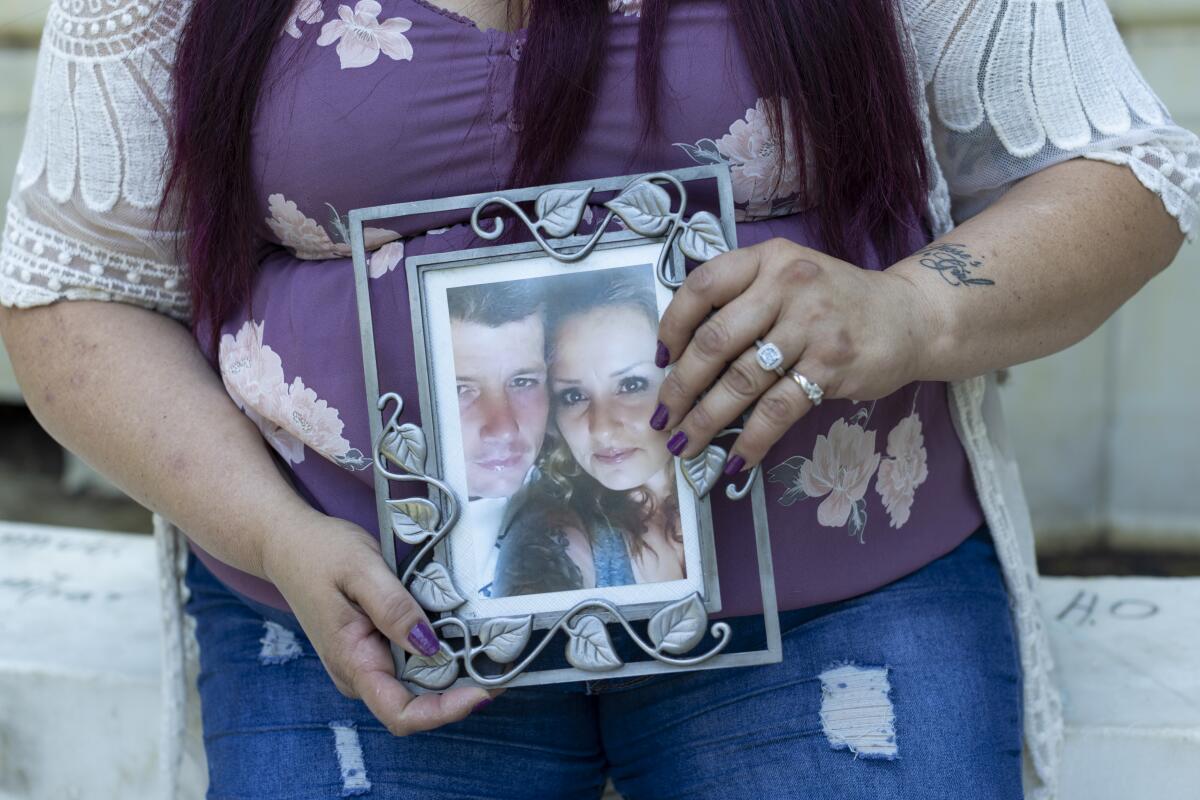Science
In California, opioid settlement money helps fund lifesaving drugs and police projects

Sonja Verdugo lost her husband to an opioid overdose last year. She regularly delivers medical supplies to people using drugs who are living — and dying — on the streets of Los Angeles. And she advocates at Los Angeles City Hall for policies to address addiction and homelessness.
Yet Verdugo didn’t know that hundreds of millions of dollars annually are flowing to California communities to combat the opioid crisis, a payout that began in 2022 and continues through 2038.
The money comes from pharmaceutical companies that made, distributed or sold prescription opioid painkillers and which agreed to pay about $50 billion nationwide to settle lawsuits over their role in the overdose epidemic. Even though a recent Supreme Court decision upended a settlement with OxyContin maker Purdue Pharma, many other companies have already begun paying out and will continue doing so for years.
California, the most populous state, is in line for more than $4 billion.
“You can walk down the street and you see someone addicted on every corner — I mean it’s just everywhere,” Verdugo said. “And I’ve never even heard of the funds. And to me, that’s crazy.”
Across the nation, much of this windfall has been shrouded in secrecy, with many jurisdictions offering little transparency on how they’re spending the money, despite repeated queries from people in recovery and families who lost loved ones to addiction.
Meanwhile, there’s plenty of jockeying over how the money should be used. Companies are lobbying for spending on products that range from medication bottles that lock to full-body scanners to screen people entering jails. Local officials are often advocating for the fields they represent, whether it’s treatment, prevention, or harm reduction. And some governments are using it to plug budget gaps.
In California, local governments must report how they spend settlement funds to the state’s Department of Health Care Services, but there’s no requirement that the reports be made public.
KFF Health News obtained copies of the documents via a public records request and is now making available for the first time 265 spending reports from local governments for fiscal year 2022-23, the most recent reports filed.
The reports provide a snapshot of the early spending priorities, and tensions.
Naloxone an early winner
As of June 2023, the bulk of opioid settlement funds controlled by California cities and counties — more than $200 million — had yet to be spent, the reports show. It’s a theme echoed nationwide as officials take time to deliberate.
The city and county of Los Angeles accounted for nearly one-fifth of that unspent total, nearly $39 million, though officials say that since the report was filed they’ve begun allocating the money to recovery housing and programs to connect people who are homeless with residential addiction treatment.
Among local governments that did use the cash in the first fiscal year, the most popular object of spending was naloxone, a medication that reverses opioid overdoses and is often known by the brand name Narcan. The medication accounted for more than $2 million in spending across 19 projects.
One of those projects was in Union City, in the San Francisco Bay Area. The community of about 72,000 residents had five suspected fentanyl overdoses, two of them fatal, within 24 hours in September.
The opioid settlement money “was invaluable,” Corina Hahn, the city’s director of community and recreation services, said in her report. “Having these resources available helped educate, train and distribute the Narcan kits to parents, youth and school staff.”
Union City bought 500 kits, each containing two doses of naloxone. The kits cost about $13,500, with an additional $56,000 set aside for similar projects, including backpacks containing Narcan kits and training materials for high school students.
Union City also plans to expand its outreach to homeless people to fund drug education and recovery services, including addiction counseling.
Those are the sorts of lifesaving services that Verdugo, the Los Angeles advocate, said are desperately needed as deaths of people living on the streets pile up.
She lost her 46-year-old husband, Jesse Baumgartner, in June 2023 to an addiction that started after he was prescribed pain medications for a high school wrestling injury. He tried kicking his habit for six years using methadone, but each time prescribers lowered his dosage the cravings drove him back to illicit drugs.
“It was just this horrible roller coaster of him not being able to get off of it,” Verdugo said.

Sonja Verdugo lost her 46-year-old husband, Jesse Baumgartner, in June 2023 to complications from an opioid addiction. She’s now a community organizer for Ground Game LA.
(Arlene Mejorado / For KFF Health News)
By then the couple had survived 4½ years of being homeless and had been in stable housing for about two years.
Fentanyl use, particularly among homeless people, “is just rampant,” she said. People sometimes are initially exposed to the cheap, highly addictive substance unknowingly when it is mixed with something else.
“Once they start using it, it’s like they just can’t backtrack,” said Verdugo, who works as a community organizer for Ground Game LA.
So she leaves boxes of naloxone at homeless encampments in the hope of saving lives.
“They definitely use it, because it’s needed right then — they can’t wait for an ambulance to come out,” she said.
Cities backtrack on spending for law enforcement
By contrast, the cities of Irvine and Riverside listed plans to prioritize law enforcement by buying portable drug analyzers, though neither city did so in the first fiscal year, 2022-23. Their inclination mirrored patterns elsewhere in the country, with millions in settlement funds flowing to police departments and jails.
But such uses of the money have stirred controversy, and both cities backed away from the drug analyzer purchase after the Department of Health Care Services issued rules that opioid settlement funds may not be used for certain law enforcement efforts. The rules specifically excluded “equipment for the purpose of evidence gathering for prosecution, such as the TruNarc Handheld Narcotics Analyzer.”
In Hawthorne the police department had already spent about $25,000 of settlement funds on an initial installment to buy 80 BolaWraps, devices that shoot Kevlar tethers to wrap around a person’s limbs or torso.
After the state said BolaWraps were not an allowable expense, the city said it would find other funding sources to pay the remaining installments.
Santa Rosa, in California’s wine country, spent nearly $30,000 on police officer wellness and support.
The funds allowed the police department to boost its contracted wellness coordinator from a part-time to a full-time position, and to buy a mobile machine to measure electrical activity in the brain, said Sgt. Patricia Seffens, a spokesperson.
The goal is to use the technology on police officers to help “assess the traumatic impact of responding to the increasing overdose calls,” Seffens said in an email.
In Dublin, east of San Francisco, officials are using part of their $62,000 settlement for a DARE program.
DARE, which stands for Drug Abuse Resistance Education, is a series of classes taught by police officers in schools to encourage students to avoid drugs. It was initially developed during the “Just Say No” campaign in the 1980s.
Studies have found inconsistent results from the program and no long-term effects on drug use, leading many researchers to dismiss it as “ineffective.”
But on its website, DARE cites studies since the program was updated in 2009, which found “a positive effect” on fifth- graders and “statistically significant reductions” in drinking and smoking about four months after completing the program.
“The DARE program when it first came out looks a lot, lot different than what it looks like right now,” said Nate Schmidt, the Dublin police chief.
Schmidt said that additional settlement money will be used to distribute naloxone to residents and to stock it at schools and city facilities.
Other local governments in California spent modest sums on a wide range of addiction-related measures. Ukiah, in Mendocino County, north of San Francisco, spent $11,000 for a new heating and air conditioning system for a local drug treatment center. Orange and San Mateo counties spent settlement funds in part on medication-assisted treatment for people incarcerated in their jails. The city of Oceanside spent $16,000 to showcase drug prevention art and videos made by middle school students in local movie theaters, public spaces, and on buses and taxis.
The Department of Health Care Services said it plans to release a statewide report on how the funds were spent, as well as the individual city and county reports, by year’s end.

Science
Owners of mobile home park destroyed in the Palisades fire say they’re finally clearing the debris

Former residents of the Palisades Bowl Mobile Home Estates, a roughly 170-unit mobile home park completely destroyed in the Palisades fire, received a notice Dec. 23 from park owners saying debris removal would start as early as Jan. 2.
The Bowl is the largest of only a handful of properties in the Palisades still littered with debris nearly a year after the fire. It’s left the Bowl’s former residents, who described the park as a “slice of paradise,” stuck in limbo.
The email notice, which was reviewed by The Times, instructed residents to remove any burnt cars from their lots as quickly as possible, since contractors cannot dispose of vehicles without possessing the title. It followed months of near silence from the owners.
“The day before Christmas Eve … it triggers everybody and throws everybody upside down,” said Jon Brown, who lived in the Bowl for 10 years and now helps lead the fight for the residents’ right to return home. “Am I liable if I can’t get this done right now? Between Christmas and New Year’s? It’s just the most obnoxious, disgusting behavior.”
Brown is not optimistic the owners will follow through. “They’ve said things like this before over the years with a bunch of different things,” he said, “and then they find some reason not to do it.”
Earlier this year, the Federal Emergency Management Agency denied requests from the city and the Bowl’s owners to include the park in the U.S. Army Corps of Engineers cleanup program, which FEMA said was focused on residential lots, not commercial properties. In a letter, FEMA argued it could not trust the owners of the Bowl to preserve the beachfront property as affordable housing.
A tattered flag waves in the wind at Asilomar View Park overlooking the Pacific Palisades Bowl Mobile Estates.
(Myung J. Chun/Los Angeles Times)
The Bowl, which began as a Methodist camp in the 1890s, was purchased by Edward Biggs, a Northern California real estate mogul, in 2005 and split between his first and second wives after his death in 2021. The family has a history of failing to perform routine maintenance and seeking to redevelop the park into a more lucrative resort community.
After FEMA’s rejection, the owners failed to meet the City of L.A.’s debris removal deadlines. In October, the city’s Board of Building and Safety Commissioners declared the park a public nuisance alongside seven other properties, giving the city the authority to complete the debris removal itself and charge the owners the bill.
But the city has yet to find funds to front the work, which is expected to cost millions.
On Dec. 10, City Councilmember Traci Park filed a motion that would order the city to come up with a cost estimate for debris removal and identify funding sources within the city. It would also instruct the city attorney’s office to explore using criminal prosecution to address the uncleared properties.
The Department of Building and Safety did not immediately respond to requests for comment.
Despite the recent movement on debris removal, residents of the Palisades Bowl still have a long road ahead.

On Wednesday, numerous burnt out vehicles still remained at the Pacific Palisades Bowl Mobile Estates. The owners instructed residents they must get them removed as quickly as possible.
(Myung J. Chun/Los Angeles Times)
In mobile home parks, tenants lease their spaces from the landowners but own the homes placed on the land. Before residents can start rebuilding, the Bowl’s owners need to replace or repair the foundations for the homes; fix any damage to the roads, utilities and retaining walls; and rebuild facilities like the community center and pool.
The owners have not responded to multiple requests for comment, but in February, Colby Biggs, Edward Biggs’ grandson, told CalMatters that “If we have to go invest $100 million to rebuild the park and we’re not able to recoup that in some fashion, then it’s not likely we will rebuild the park.”
Mobile home law experts and many residents doubt that the Biggs family would be able to convert the rent-controlled mobile home park into something else under existing law. The most realistic option, should the Biggs decide against rebuilding, would be to sell the park to another owner — or directly to the residents, a course of action the residents have been actively pursuing.
The lack of communication and action from the owners has nonetheless left the Bowl’s eclectic former community of artists, teachers, surfers, first responders and retirees in limbo.
Many are running out of insurance money for temporary housing and remain unsure whether they’ll ever be able to move back.
Science
Video: Drones Detect Virus in Whale Blow in the Arctic

new video loaded: Drones Detect Virus in Whale Blow in the Arctic

By Jamie Leventhal and Alexa Robles-Gil
January 2, 2026
Science
Commentary: ‘Stop exercising, you’re killing yourself.’ Not really, but try more nurture, less torture in 2026

One day my left foot hurt for no good reason. I stood up to shake off the pain and tweaked my right Achilles tendon, so I headed for the medicine cabinet, bent over like an ape because of a stiff back.
Actually, I lied.
It wasn’t one day. It’s pretty much every day.
None of this is severe or serious, and I’m not complaining at the age of 72. I’m just wondering.
Are my exercise routines, which were meant to keep me from falling apart, slowing my demise, or accelerating it?
What better time than the start of a new year to get an answer? In one poll, the top New Year’s resolution for 2026 is exercising more. Also among the top six resolutions are eating healthier, improving physical health and losing weight, so good luck to all you dreamers, and I hope you last longer than I have with similar resolutions.
Instead of a resolution, I have a goal, which is to find a sweet spot — if there is one — between exercise and pain.
Maybe I’m asking too much. I’ve had two partial knee replacements, I’ve got a torn posterior cruciate ligament, a scar tissue knob on a frayed Achilles tendon, a hideously pronated left foot, a right shoulder that feels like it needs an oil change, and a pacemaker that keeps on ticking.
But I decided to get some expert advice that might be useful for anyone who has entered this glorious phase of life in which it’s possible to pull a muscle while taking a nap, or pinch a nerve in your neck while brushing your teeth.
And I knew just whom to call.
Cedars-Sinai orthopedic surgeon Robert Klapper hosts an ESPN radio show called “Weekend Warrior.” This lab-coated Renaissance man, a surfer and sculptor in his spare time, also weighs in regularly on the radio with “Klapper Vision” — clear-eyed takes on all manner of twisted, pulled and broken body parts suffered by elite athletes and banged-up buzzards like me.
On “Weekend Warrior,” Klapper might be talking about knee replacement surgery one minute, segue to Michelangelo’s rendering of the human form, and then insist that a sandwich is not a sandwich without peperoncini. It isn’t necessarily all connected, but it doesn’t matter.
When I emailed Klapper about my aches and pains, he responded immediately to say he’s written one book on hips, another on knees and a third one is in the works with the following title:
“Stop Exercising, You’re Killing Yourself.”
No, he’s not saying you should never get off the sofa. In a phone conversation and later at his office, Klapper said the subtitle is going to be, “Let Me Explain.” He’s making a point about what kind of exercise is harmful and what kind is helpful, particularly for people in my age group.
Dr. Robert Klapper holds up his book about preventing hip surgery.
(Genaro Molina/Los Angeles Times)
My daily routine, I told him, involves a two-mile morning walk with my dog followed by 30 minutes of swimming laps or riding a stationary bike.
So far, so good.
But I also play pickleball twice a week.
“Listen, I make a living from pickleball now,” Klapper said. “Exercise is wonderful, but it comes in two flavors.”
One is nurturing, which he calls “agercise” for my demographic.
The other is abusive, and one of Klapper’s examples is pickleball. With all its starts and stops, twists and turns, reaches and lunges, pickleball is busting the Medicare bank, with a few hundred million dollars’ worth of injuries each year.
I know. The game looks pretty low key, although it was recently banned in Carmel-by-the-Sea because of all the racket. I had no idea, when I first picked up a paddle, that there’d be so much ice and ibuprofen involved, not to mention the killer stares from retirees itching for a chance to drill you in the sternum with a hot laser.
“This is a sport which has the adrenaline rushing in every 50-year-old, 60-year-old, 80-year-old,” Klapper told me in his office, which is the starting point in his joint replacement factory. The walls are covered with photos of star athletes and A-list Hollywood celebrities he’s operated on.
“I see these patients, but they’re not coming to me with acute injuries. They didn’t snap their Achilles tendon … like they do in tennis. They’re not snapping their ACL like they are in pickup basketball,” Klapper said. “They’re coming to me saying, ‘My shoulder is killing me, my knee is killing me.’ ”
Pickleball has obvious conditioning benefits for every age group. But it can also worsen arthritis and accelerate joint degeneration, Klapper said, particularly for addicts who play several times a week.
Not that he’s the first MD to suggest that as you age, walking, cycling and swimming are easier on your body than higher-impact activities. As one doctor said in an AARP article on joint care and the benefits of healthy eating, watching your weight and staying active, “the worst thing you can do with osteoarthritis after 50 is be sedentary.”
Still, I thought Klapper might tell me to stop pickling, but he didn’t.
“Pickleball is more than a sport to you … and all of your compadres,” he said. “It’s mental. You need it because of the stress. The world’s falling apart.… I want you to play it, but I want you to do the nurturing exercises so you can do the abuse.”
There’s no fountain of youth, Klapper said, but the closest thing is a swimming pool.
OK, but I already swim three times a week.

Dr. Robert Klapper meets with patient Kathleen Clark, who is recovering from knee surgery.
(Genaro Molina/Los Angeles Times)
Klapper had different ideas.
“You need to be walking forward and backwards for half an hour,” he said. Do that three times a week, he told me, and ride a stationary bike three times.
Why the water walking?
“We as humans take over a million steps a year. Forget pickleball, just in … daily living,” Klapper said, so I’m well beyond 72 million steps.
“Think about that,” he said.
Do I have to?
Water walking will develop muscles and joints without the stress of my full weight, and that could “optimize” my pickleball durability and general fitness, Klapper said. Buoyancy and the touch of water on skin are magic, he said, but there’s science involved too.
“It’s hard to move your arms and legs and your body through water, and yet it’s unloading the joint,” Klapper said. “And finally — and this is the real X factor — when you close your eyes and straighten your elbow and bend your elbow, straighten your knee and bend your knee … your brain knows where your limbs are in space.”
This is called proprioception, Klapper said. Receptors in your skin, muscles, ligaments and tendons send messages to your brain, leading to better balance, coordination and agility and potentially reducing risk of injury.
There are lots of exercises for sharpening proprioception, but the surfing doctor is partial to bodies of water. At my age, he said, my proprioception “batteries are running low,” but I can recharge them with a short break from pickleball and a focus on the pool.
“You can’t guarantee anything in life and medicine,” Klapper said. “But I guarantee you, a month into it, you’re going to feel so much better than you do at this moment.”
It’s worth a try, and I’ll let you know how it goes.
In the pool and on the court.
steve.lopez@latimes.com
-

 World1 week ago
World1 week agoHamas builds new terror regime in Gaza, recruiting teens amid problematic election
-

 Indianapolis, IN1 week ago
Indianapolis, IN1 week agoIndianapolis Colts playoffs: Updated elimination scenario, AFC standings, playoff picture for Week 17
-

 Business1 week ago
Business1 week agoGoogle is at last letting users swap out embarrassing Gmail addresses without losing their data
-

 Southeast1 week ago
Southeast1 week agoTwo attorneys vanish during Florida fishing trip as ‘heartbroken’ wife pleads for help finding them
-

 World1 week ago
World1 week agoSnoop Dogg, Lainey Wilson, Huntr/x and Andrea Bocelli Deliver Christmas-Themed Halftime Show for Netflix’s NFL Lions-Vikings Telecast
-

 Politics1 week ago
Politics1 week agoMost shocking examples of Chinese espionage uncovered by the US this year: ‘Just the tip of the iceberg’
-

 News1 week ago
News1 week agoRoads could remain slick, icy Saturday morning in Philadelphia area, tracking another storm on the way
-

 World1 week ago
World1 week agoPodcast: The 2025 EU-US relationship explained simply

















